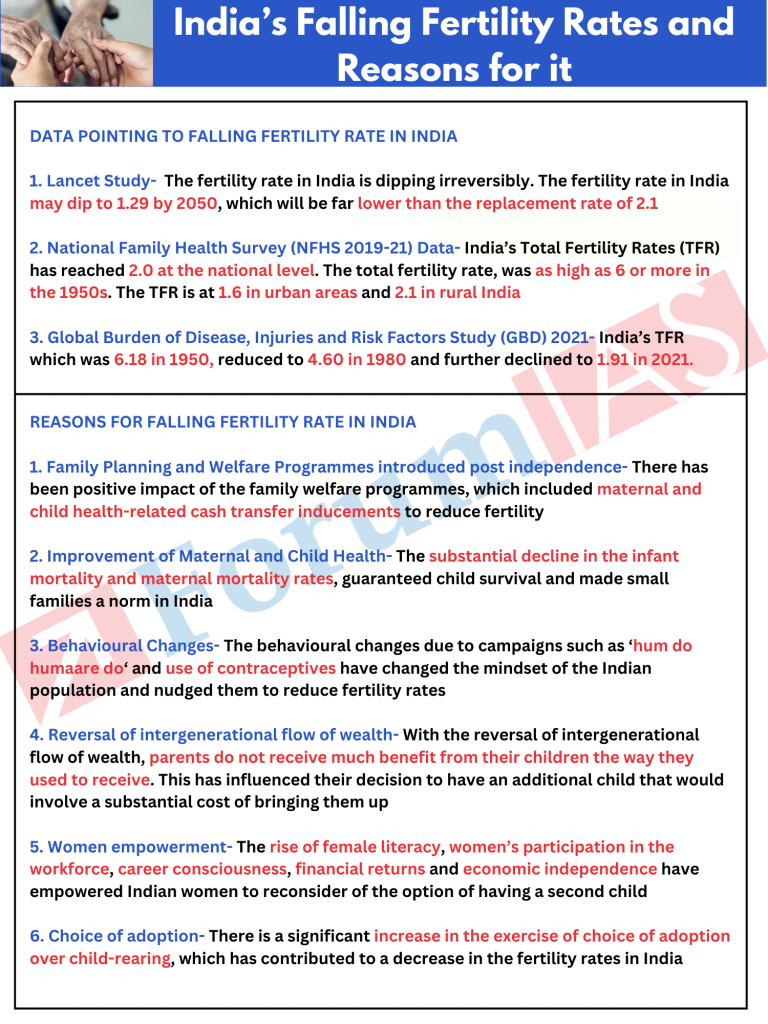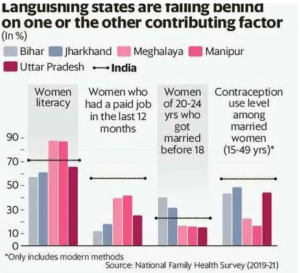ForumIAS announcing GS Foundation Program for UPSC CSE 2025-26 from 19 April. Click Here for more information.
According to a recent Lancet study, the falling fertility rate in India is irreversible. According to the forecast of the study, the fertility rate in India may dip to 1.29 by 2050, which will be far lower than the replacement rate of 2.1. This points to a rapidly depleting working age population in India. While the declining fertility rate has its own advantages, it’s dropping below the replacement rate has some perilous consequences.

What is Total Fertility Rate? What is the trend of falling fertility rate in India?
Fertility Rate/TFR- Total fertility rate (TFR) refers to the total number of children born or likely to be born to a woman (15-49 years) in her lifetime.
Replacement level fertility rate- A TFR of 2.1 is known as replacement level fertility rate. It is the level of fertility at which a population exactly replaces itself from one generation to the next.
TFR< Replacement level fertility rate- TFR lower than 2.1 children per woman indicates that a generation is not producing enough children to replace itself. This eventually leads to an outright reduction in population.
Data Pointing to falling fertility rate in India
National Family Health Survey (NFHS 2019-21) Data
a. India’s Total Fertility Rates (TFR) has reached 2.0 at the national level. The total fertility rate, was as high as 6 or more in the 1950s.
b. The TFR is at 1.6 in urban areas and 2.1 in rural India.
c. Bihar, Meghalaya, Uttar Pradesh, Jharkhand and Manipur remain the only states with fertility rates above the replacement level and the national average.
Global Burden of Disease, Injuries and Risk Factors Study (GBD) 2021
a. India’s TFR which was 6.18 in 1950, reduced to 4.60 in 1980 and further declined to 1.91 in 2021.
b. Worldwide also, the TFR has more than halved in the last 70 years, from around five children for each woman in 1950 to 2.2 children in 2021.
What are the reasons for falling fertility rate in India?
1. Family Planning and Welfare Programmes introduced post independence- There has been positive impact of the family welfare programmes, which included maternal and child health-related cash transfer inducements to reduce fertility.
2. Improvement of Maternal and Child Health- Another major reason for falling fertility rate in India, is the substantial decline in the infant mortality and maternal mortality rates. The decline in these rates guaranteed child survival and made small families a norm in India.
3. Behavioural Changes- The behavioural changes due to campaigns such as ‘hum do humaare do‘ and use of contraceptives have changed the mindset of the Indian population and nudged them to reduce fertility rates.
4. Reversal of intergenerational flow of wealth- With the reversal of intergenerational flow of wealth, parents do not receive much benefit from their children the way they used to receive. This has influenced their decision to have an additional child that would involve a substantial cost of bringing them up.
5. Women empowerment- The rise of female literacy, women’s participation in the workforce, career consciousness, financial returns and economic independence have empowered Indian women to reconsider of the option of having a second child.
6. Choice of adoption- There is a significant increase in the exercise of choice of adoption over child-rearing, which has contributed to a decrease in the fertility rates in India.
What is the significance of falling fertility rates for India?
1. Improved labour productivity leading to accelerated economic growth- The decline in population growth would increase the amount of capital resources and infrastructure available in per capita terms. A young skilled workforce would improve labour productivity, leading to accelerated economic growth.
2. Better employment conditions for workers- A lower working force population will result in improved working conditions and higher wages for the workers. It would also lead to elimination of wage discrimination for migrant workers and the mitigation of their security concerns in the industrially developed states (southern states, Maharashtra, Gujarat), that have low fertility rates.
3. Enhanced participation of women in workforce- With decline in fertility rate, less time is needed for childcare, which enhances the participation of women in workforce. For ex- Improved share of women in MNREGA employment in Southern States.
4. Improvement in quality of Social service deliveries- Falling fertility rate improves the educational, health and skills of Indian population due to increase in the per capita availability of social sector resources and infrastructure like schools, colleges and hospitals.
5. Reduced pressure on environment and agriculture- The impact of environmental problems such as global warming, desertification, loss of farmland, pollution and use of non-renewable materials will be reduced due to decline in population.
What are the concerns with the fertility rates falling below the replacement levels?
1. Demographic disadvantage- Fertility rates, falling below the replacement level of TFR 2.1, leads to the problem of demographic disadvantage of an ageing population. For ex- China’s demographic disadvantage due to falling fertility rate.
2. Increase in ‘non-developmental expenditure’- Drastic fall in fertility rate will lead to increase in government’s non-developmental expenditure on pensions and subsidies, due to increase in aged population and shrinking of workforce.
3. Labour shortages endangering economic stability- Substantial decrease in the working age population will India’s economic and social stability. For ex- Decline in Japan’s economic growth rates due to shrinking labour force.
4. Less ‘brain pool’ for innovation- Young people are the ‘brain pool’ for entrepreneurship, innovation and new technologies development. With less young people in the population pyramid due to decrease in fertility rate, the potential ‘brain pool’ for innovation will be lesser.
5. Potential social imbalances- The Declining rate of fertility can lead to social imbalances due to gendered preference of having a male child. This can lead to an increase in the son-meta preference and skewed sex-ratios.
| Read More- Young and the old – lancet report on fertility rate |
What Should be the way Forward?
1. Implement Scandinavian countries model of ‘supporting new families’- The Scandinavian countries model of ‘supporting new families’ by providing affordable childcare, investment in healthcare and large-scale male-engagement initiatives to build gender equity, must be implemented in India at the earliest.
2. Men assuming greater household responsibilities- Men taking up greater responsibilities of household and care work would help women in better management of motherhood with their careers. This would consequently lead to working women choosing child-rearing instead of adoption.
3. Tweaking of economic policy and agenda- Economic policies that stimulate growth and job creation, alongside social security and pension reforms, will also be essential in mitigating the impacts of declining fertility rate.
4. Designing policies for ethical and effective migration- The policies for ethical and effective inter-state migration must be designed to offset the regional imbalances due to falling rates of fertility in southern states of India.
| Read More- The Indian Express UPSC Syllabus- GS 1- Population and Associated Issues |






